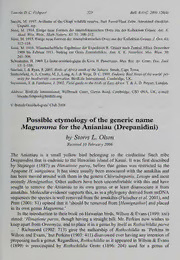
Possible etymology of the generic name Magumma for the Anianiau (Drepanidini) PDF
Preview Possible etymology of the generic name Magumma for the Anianiau (Drepanidini)
LincolnD. C. Fishpool 323 Bull. B.O.C. 2006126(4) Sacchi, M. 1997. Avifauna ofthe Okapi wildlife reserve, Ituri Forest/Haut Zaire. Annotated checklist. Unpubl. rep. Sassi, M. 1914. Einige neue Formen der innerafrikanischen Ornis aus der KoUektion Grauer. Anz. K. Akad. Wiss, Wein., Math-Natum'. Kl. 5\: 308-312. Sassi,M. 1915.EinigeneueFormenderinnerafrikanischenOrnisausderKoUektionGrauer./. Orn. 63: 112-118. Sassi, M. 1916. Wissenschaftliche Ergebnisse derExpedition R. GrauernachZentralAfrica Dezember 1909 bis Februar 1911. Beitrag zur Ornis Zentralafrikas. Ann. K. K. Naturhist. Mus. Wien. 30: 241-306. Schouteden,H. 1969. LafauneomithologiqueduKivu. II. Passereaux.Mus. Roy.Afr. Centr., Doc. Zool. 15: 1-188. Sinclair, I. &Ryan,R 2003.BirdsofAfricasouthoftheSahara. Struik, CapeTown. Stattersfield,A.J.,Crosby,M.J.,Long,A.J.&Wege,D.C. 1998.EndemicBirdAreasoftheworld:pri- orityforbiodiversityconservation. BirdLifeInternational,Cambridge,UK. Stevenson,T. &.Fanshawe,J. 2002.FieldguidetothebirdsofEastAfrica. T. &A. D. Poyser,London. Address: BirdLife International, Wellbrook Court, Girton Road, Cambridge, CB3 ONA, UK, e-mail: [email protected] ©BritishOrnithologists'Club2006 Possible etymology ofthe generic name Magumma for the Anianiau (Drepanidini) by Storrs L. Olson Received 10February 2006 The Anianiau is a small yellow bird belonging to the cardueline finch tribe Drepanidini that is endemic to the Hawaiian island ofKauai. It was first described by Stejneger (1887) as Himatione parva, before that genus was restricted to the Apapane H. sanguinea. It has since usually been associated with the amakihis and has been moved around with them in the genera Chlorodrepanis, Loxops and most recently Hemignathus. Other authors have been uncomfortable with this and have sought to remove the Anianiau to its own genus or at least disassociate it from amakihis. Molecularevidence supportsthis, as inaphylogenyderivedfrommtDNA sequencesthe species iswellremovedfromtheamakihis (Fleischeretal. 2001), and Pratt (2001: 81) opined that h 'should be removed from [Hemignathus'] and placed in its own genusMagumma.' Inthe introductionto theirbookonHawaiianbirds, Wilson& Evans (1899: xxi) stated: 'Himationeparva, though having a straight bill, Mr. Perkins now wishes to keep apart from Oreomyza, andtoplace it in agenus byitselfasRothschildiaparva ... .' Richmond (1902: 713) gave the authorship oi Rothschildia as 'Perkins in Wilson andEvans,'butPerkins (1903: 411) disavowedeverhaving any intention of proposing such a genus. Regardless,Rothschildia as it appeared inWilson & Evans (1899) is preoccupied by Rothschildia Grote (1896: 204) used for a genus of — StoiTSL. Olson 324 Bull. B.O.C. 2006126(4) Lepidoptera. There was also a subsequent use of Rotschildia {sic, lapsus) in Amphibia (Mocquard 1905). Mathews (1925: 93), in a spate of 17 new genera, proposed the generic name MagummaasareplacementforRothschildia,withHimationeparva Stejnegerasthe type. He gave no explanation ofthe meanings ofany ofthe new names. Ifnotpure nonsense, what could be the derivation ofthe uncouth wordMagumma? GregoryM. Mathewswasoneofthemostnotoriousandprolific generic splitters inthe history ofornithology, proposing about 536 new generic names (M. D. Bruce in litt. 29 June 2002). To maintain his furious pace he had to strain mightily and many ofhis names were etymologically dreadful, but there often seems to be some sort ofreasoning behind them (e.g. Tomirdus, named for Tom Iredale and used for the rail now known as Rallina tricolor). One device ofthe desperate word coiner is to resort to anagrams. The letters of Magumma canbe rearranged in only one waythat spells something recognisable gamma mu, the Greek letters equivalent in Latin to G andM. They also happen to be the initials of Gregory Mathews. Though it cannot be proved, it appears that Mathews may have cryptically named this new genus forhimself Acknowledgements IthankMurrayD. BruceandJamesJoblingforcommentingonthemanuscript. References: Fleischer,R.C,Tarr,C.L.,James,H.R, Slikas,B. &Mcintosh,C.E. 2001.Phylogeneticplacementof the Po'ouli, Melamprosopsphaeosoma, based on mitochondrial DNA sequence and osteological characters.Stud.AvianBiol. 22: 98-103. — Grote,A. R. 1896. BeitragezurClassificationderSchmetterling. DieNachtpfauenaugenmitbesonder Beriicksichtigung ihrerFliigelbildung. Verhand. GesellschaftDeutsch. Naturforscher u. Aertze 68: 197-208. Mathews,G. M. 1925. [Descriptionsofnewgeneraofbirds].Bull. Brit. Orn. CI. 45: 93-94. Mocquard, F. 1905. Notepreliminaire surune collectiondereptiles etdebatraciens offerte aumuseum parM. MauricedeRothschild.Bull. Mus. Nad. d'Hist. Naturelle{\) 11: 285-290. Perkins,R. C. L. 1903.Vertebrata.Pp. 365^66in Sharp,D. (ed.)FaunaHawaiiensisortheZoologyof theSandwich (Hawaiian)Islands,vol. 1,pt.4. CambridgeUniv. Press. Pratt, H. D. 2001. WhytheHawai'i Creeperis an Oreomystis: whatphenotypic charactersrevealabout thephylogenyofHawaiianhoneycreepers.Stud.AvianBiol. 22: 81-97. Richmond,C.W. 1902.Listofgenerictermsproposedforbirdsduringtheyears 1890to 1900,inclusive, to which are added names omitted by Waterhouse inhis "Index GenerumAvium."Proc. USNatl. Mus. 24: 663-729. Stejneger,L.H. 1887.BirdsofKauaiIsland,Hawaiianarchipelago,collectedbyMr.ValdemarKnudsen, withdescriptionsofnewspecies.Proc. USNatl. Mus. 10: 75-102. Wilson, S. B. & Evans, A. H. 1890-99. Aves Hawaiienses: the birds ofthe Sandwich Islands. R. H. Porter, London. Address: Division of Birds, National Museum ofNatural History, Smithsonian Institution, P.O. Box 37012, Washington DC,20013-7012,USA. ©BritishOrnithologists'Club2006
